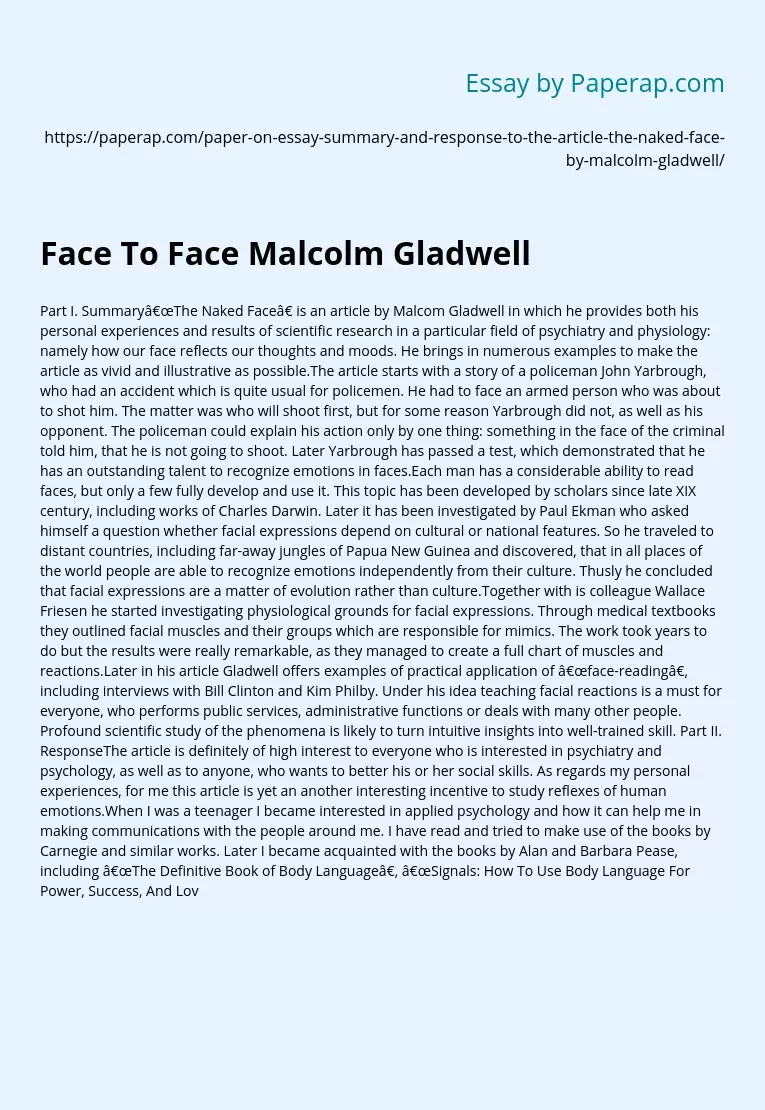Face to Face by Malcolm Gladwell
The following sample essay is about the book Face to Face by Malcolm Gladwell. Read the introduction, body and conclusion of the essay, scroll down.
Part I.
Summary“The Naked Face” is an article by Malcom Gladwell in which he provides both his personal experiences and results of scientific research in a particular field of psychiatry and physiology: namely how our face reflects our thoughts and moods. He brings in numerous examples to make the article as vivid and illustrative as possible.
The article starts with a story of a policeman John Yarbrough, who had an accident which is quite usual for policemen. He had to face an armed person who was about to shot him. The matter was who will shoot first, but for some reason Yarbrough did not, as well as his opponent. The policeman could explain his action only by one thing: something in the face of the criminal told him, that he is not going to shoot.
Later Yarbrough has passed a test, which demonstrated that he has an outstanding talent to recognize emotions in faces.Each man has a considerable ability to read faces, but only a few fully develop and use it. This topic has been developed by scholars since late XIX century, including works of Charles Darwin. Later it has been investigated by Paul Ekman who asked himself a question whether facial expressions depend on cultural or national features. So he traveled to distant countries, including far-away jungles of Papua New Guinea and discovered, that in all places of the world people are able to recognize emotions independently from their culture.
Thusly he concluded that facial expressions are a matter of evolution rather than culture.Together with is colleague Wallace Friesen he started investigating physiological grounds for facial expressions. Through medical textbooks they outlined facial muscles and their groups which are responsible for mimics. The work took years to do but the results were really remarkable, as they managed to create a full chart of muscles and reactions.Later in his article Gladwell offers examples of practical application of “face-reading”, including interviews with Bill Clinton and Kim Philby. Under his idea teaching facial reactions is a must for everyone, who performs public services, administrative functions or deals with many other people. Profound scientific study of the phenomena is likely to turn intuitive insights into well-trained skill.
Part II.
ResponseThe article is definitely of high interest to everyone who is interested in psychiatry and psychology, as well as to anyone, who wants to better his or her social skills. As regards my personal experiences, for me this article is yet an another interesting incentive to study reflexes of human emotions.When I was a teenager I became interested in applied psychology and how it can help me in making communications with the people around me. I have read and tried to make use of the books by Carnegie and similar works. Later I became acquainted with the books by Alan and Barbara Pease, including “The Definitive Book of Body Language”, “Signals: How To Use Body Language For Power, Success, And Love”, and others related to body language.Watching myself and others I have discovered, that body and facial language is in fact highly applicable and useful in our daily life. It does not only help us to understand each other better and avoid misreading of communicational messages, but it can also assist in creating necessary moods for ourselves and others. For example, when I am bored or depressed I use to change my body position and face, and this often helps to feel better.However, all the studies which I have read were more of popular nature. The article by Gladwell adds theoretical understanding of deep psychiatric processes, influencing facial expressions. It also wakens more interest to further studies on the subject. This can be compared to practical and theoretical physics. Anyone can read faces after being properly trained same as anyone can use electricity in his or her household. However, only theoretical studies can help in understanding what stands behind certain movements of facial muscles same as only formulas and theories give knowledge of what electricity is, how it appears and works.
Face to Face by Malcolm Gladwell. (2019, Dec 05). Retrieved from https://paperap.com/paper-on-essay-summary-and-response-to-the-article-the-naked-face-by-malcolm-gladwell/

